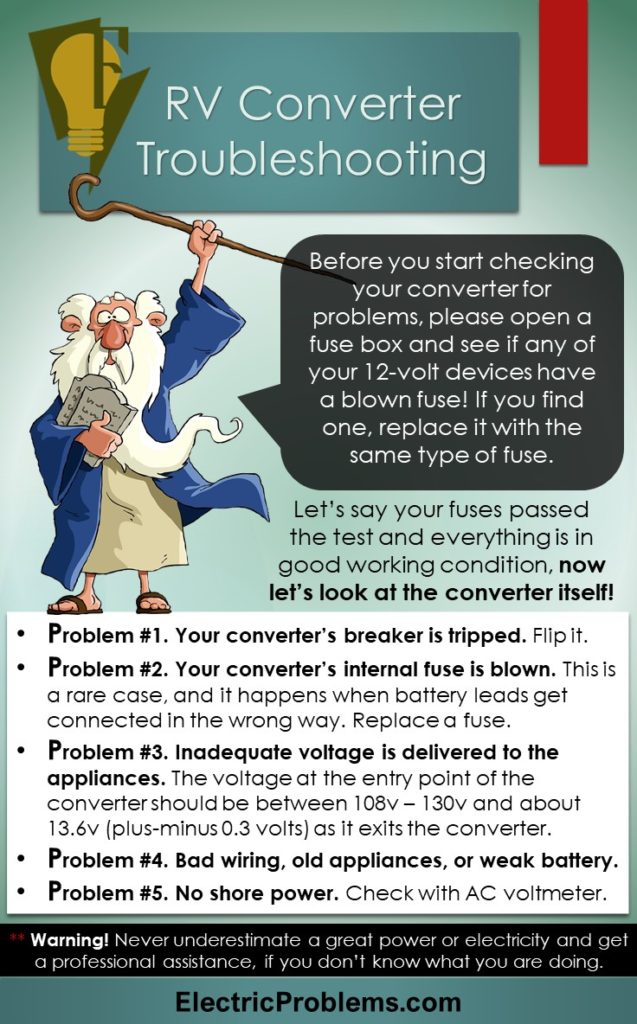RV Power Converters [How to Troubleshoot]
DISCLAIMER: AS AN AMAZON ASSOCIATE I EARN FROM QUALIFYING PURCHASES. THIS POST CONTAINS AFFILIATE LINKS THAT WILL REWARD ME MONETARILY OR OTHERWISE WHEN YOU USE THEM TO MAKE QUALIFYING PURCHASES. FOR MORE INFORMATION, PLEASE READ MY EARNINGS DISCLAIMER.
|
Troubleshooting a converter in RV generally involves checking for blown fuses that could have interrupted your circuit and for general power supply problems. A breaker that powers your inverter could have tripped or there is no shore power at all!
AC/DC converter is a very important device, that is placed in between your AC (Alternate Current) breaker panel and DC (Direct Current) fuse panel. It is responsible for converting standard 120-volt power into 12-volt for powering different appliances and lights.
The converter is also used for charging a home battery of your recreational vehicle unless you plug it in directly into the solar panel and this is how it gets charged. You use battery power when the main power source is not available to run your important DC appliances (like water pump, furnace, A/C, etc.) and interior lights.
Following are the basic converter troubleshooting steps:
- Step#1. Check appliance fuses.
- Step#2. Check your converter breaker.
- Step#3. Check incoming voltage (AC).
- Step#4. Check for the DC voltage that is supposed to be coming out of your converter or DC circuit board if it is integrated.
- Step#5. Check batteries for being in good condition.
- Step#6. Check wiring and connections.
Test your converter and wires with an electricity measuring device like a voltmeter, which could come in no contact version! You generally think that the converter is a problem when you have:
- A problem with the battery. Your batteries are not charging.
- A problem with a home DC circuit. Your DC (Direct Current) devices like fans, lights, water pump, slide-outs, and some electrical appliances stopped working. Your interior lights went out or became really dim.
** Important! Before you start checking your converter for problems, please open a fuse box and see if any of your 12-volt devices have a blown fuse! If you find one, replace it with the same type of fuse.
There are three types of things that you should check for first:
- If your converter breaker tripped. To see if it tripped and disconnected your circuit, which could be a reason behind no power supplied to your devices.
- If your appliance fuse is blown. Every DC device that you have will have a fuse installed for protection of it. If it gets blown, it will disconnect the power supply to your device, and this could be a reason behind you not being able to turn it on.
- If your converter’s internal fuse is blown. If your converter is not giving you any power, it could mean that the Reverse Battery Protection fuse is blown. This is a rare case and it happens when battery leads get connected in the wrong way. Even though it is connected the right way now, your fuse may be already “out of order”.
** Please note that the converter is very often hidden within a DC panel in RVs, but in different models, you can find them as an external unit and be in various locations.
Since fuses are designed to protect your equipment from excessive current, it is also a good idea to check if they are in good working condition by testing them with the voltage tester. Also, make sure that they all match the amperage that the device needs.
If you find the following problems with your fuses, check for appliance or wiring failure, NOT converter:
- Your fuse was not working when tested.
- Your fuse was larger than the appliance requires.
The reason for this is that if your fuses were damaged (or sized wrong), they allowed too much power through and that could damage wires and connected equipment.
Let’s say your fuses passed the test and everything is in good working condition, now let’s look at the converter itself. You could have the following issues with a converter:
- Converter internal failure. Input and output should be checked with a voltage meter as shown below.
- Power supply problem. This happens when there is bad wiring involved or no main power.
- Power distribution problem. Your devices will receive no power from the converter if something is wrong with wires or connectors.
Converter internal failure
The first thing that we are going to do is to check the breakers. All you have to do is to open your circuit breaker panel and check if your breaker is flipped.
If it is, turn the converter OFF first and flip the breaker back before turning it ON again. If the breaker flips again, further converter troubleshooting will be required.
The next thing we are going to do is check the converter’s voltage range. The voltage at the entry point of the converter should be between 108v – 130v and about 13.6v (plus-minus 0.3 volts) as it exits the converter.
This is how you test RV converter:
If you figured out that your converter is “out of shape”, all you have to do is replace it with a new one. Here is a nice video about checking and replacing the RV converter:
Power distribution problems
If your breaker is NOT tripped, you might want to examine the actual DC panel for connection problems. If the devices that it is connected to are failing, it could be anything from wiring to device malfunctioning.
If you are suspecting there is a problem with your appliance, here is what to look for and troubleshoot:
Problem#1. Too much power
- Do you have a blown fuse? Check your DC circuit board for a blown fuse and replace it if needed. In order to figure out why to go to step #2.
- Are your wires in good shape? Check all the wires up to the converter in order to make sure they are not without any insulation. Unprotected or melted wires could cause a short circuit and be a cause for a blown fuse. If wires are fine, go to step #3.
- Is your appliance in good shape? For example, your appliance could be getting old and requiring more energy than your circuit can safely give you and your fuse gets blown. Check with the multimeter how much it is actually drawing from a circuit, and if it’s too much, you may want to start shopping for a replacement.
Problem#2. No power
- Is your device receiving power? The circuit board of DC devices should be checked with a voltmeter or multimeter to make sure the power is actually getting to your device. If there is no voltage coming from the DC circuit board, go to step #2.
- Are your wires connected properly? Check all your wire connections. If everything is fine there, check your wires (which could be broken or jammed). If this is not the case, go to step #3.
- Did your battery get weak? If your wires and connections are ok, check if your battery is in a good shape. Your battery is a backup in case you overwhelm your circuit with power accessories! This means if your battery is unable to hold a charge, all of your devices will suffer even while being plugged into a 120-volt AC source.
Power supply problem
This is a simple one. Just check if 120 VAC voltage is supplied to your outlet with an AC voltmeter. If there is no AC (Alternating Current) power present, you will need to check your outlet wiring.
If your wiring is fine, but there is still no AC power coming from a pedestal in an RV park, you may want to contact site management for help. If you DO have 120-volt incoming power and your converter shows 0-volt output, then it needs to be replaced.
Feel free to save this infographic pin for future reference .
Where to get a converter?
Here are some nice converter-chargers that I found on Amazon:
Did you know that there is a device called: “inverter-charger”? It is converter+inverter in one and usually comes in a much more compact version vs having inverter and converter separately.
In case your RV already has an old inverter, you may want to look at upgrading it as well and an inverter-charger is a perfect solution! Pure Sine Wave inverters are considered to be of better quality (and less noisy).
2000-watt inverter-charger is usually a perfect size for a medium-size RV. Chosen companies are known for their quality power supplies (pure sine wave):
Here is a modified sine wave version:

Click on the white button above to find your electrician!





I have a slide out that has no power to the switch that runs drive motor have a fuse that is red have swapped out fuse with same results.